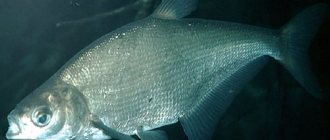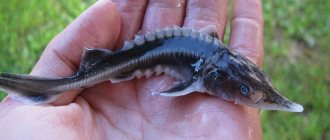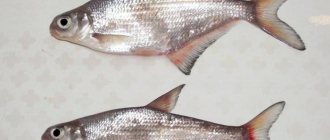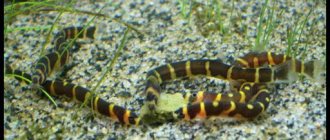In winter, different types of fish behave differently. Some hibernate throughout the cold season, and catching them becomes too problematic. Others remain active all winter, presenting great interest to anglers. And bream is closer to the latter - all winter it roams water bodies in search of food. Therefore, fishing for bream in winter with the right approach is likely to be successful and productive. However, be prepared for the fact that with the advent of cold weather, the bream does not lose its caution and does not weaken - it quickly adapts to new conditions, so you will need skill at all stages from feeding to fishing.
Winter attractant DELFI DIP WINTER SPRAY UNIVERSAL (universal, shrimp flavor, 30 ml) Tayur 80 for 1 pc. Winter bite activator. PELICAN Bloodworm (PE-045) PELICAN 242 for 1 pc. Winter attractant DELFI DIP WINTER GEL BIGFISH (big fish, worm flavor, gammarus, 20 ml) Tayur 103 for 1 piece. Aroma gel spray MIX 313 Bream (1 fl.-50 ml) (PDZ-010) PELICAN 206 for 1 pc. Winter attractant DELFI DIP WINTER GEL UNIVERSAL (universal, bloodworm flavor, 20 ml) Tayur 103 for 1 pc. Winter attractant DELFI DIP WINTER SPRAY UNIVERSAL (universal, bloodworm flavor, 30 ml) Tayur 80 for 1 pc. Winter attractant DIP WINTER SPRAY CRUCIAN (crucian carp, garlic flavor, 30 ml) Tayur 80 for 1 pc.
The most effective winter flavors
Peculiarities of bream behavior in winter
This type of fish prefers to stay in schools in winter, just as in summer. Therefore, once you get to the bream place and feed it well, you can get a decent catch in a short time. at the same time, depending on age, bream behaves differently and chooses different places:
- Young individuals mostly stay in shallow water in areas densely overgrown with algae. Here the breams get enough food and feel comfortable all winter.
- Medium-sized specimens aged 2 years and older also gather in flocks of smaller numbers but higher densities. In search of food, they go to the middle depths of the reservoir. Here, as a rule, they do not stay in one place for a long time, but migrate across the water area when food supplies run out.
- Large individuals live in flocks with a clearly visible hierarchy. There is always a leader, a “reconnaissance squad” and the bulk. The strength of a large fish is enough to open mollusk shells, so you should look for it at great depths. Moreover, with age, bream does not begin to lead a sedentary lifestyle - they still migrate across the reservoir in search of areas with sufficient food. Fishing during such migration is rarely successful - when the school moves, it practically ignores the food. The exception is scout individuals, however, they do not eat, but rather taste food to determine the attractiveness of a particular place.
At the same time, general patterns can be identified in the behavior of bream in winter that simplify its search in a reservoir. Its favorite places are areas with uneven bottom topography and pronounced depth differences. It is also worth fishing in areas of the reservoir where springs gush out from the bottom and streams and tributaries flow into them. There is always enough food collected here, in addition, the water here is richer in oxygen. Bream does not like areas with a silted bottom or snags.
Coastal areas where algae died early, before normal ice cover is established, should not be considered as a place for winter bream fishing. As vegetation decomposes, it saturates the water with unpleasant odors and consumes oxygen reserves.
How fast does bream grow?
Fishermen who are in pursuit of trophy specimens must know everything about their prey. For example, how and at what speed it can grow and develop. And for beginners in fishing, it would not hurt to also familiarize yourself with the general description of this fish.
Did you know? Fish scales are one of the components that make up lipstick. It is added to add shine to cosmetics.
The described species has a tall body. The bream is rounded towards the head and more elongated towards the tail. Its height can reach up to a third of its body length. The mouth of this fish ends in a tube that tends to extend. The young have gray scales. Adults have a silver or brown back, a yellowish belly and light brown sides with a golden tint.
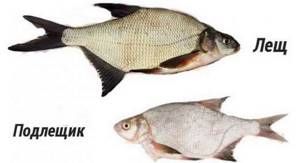
Dimensions
The maximum length to which bream can grow is 82 cm.
Find out the difference between bream and silver bream.
The growth rate directly depends on:
- nutrition;
- habitats.
When catching artificially grown fish, individuals are usually found that have reached up to 35 cm in length. But wild specimens, which are caught in ponds and rivers, can reach up to 60 cm. The table below provides approximate data on the body length of bream at a given age.
| Age | Body size |
| 3 years | up to 15 cm |
| 5 years | up to 25 cm |
| 7 years | 35–40 cm |
| 10 years | 40–50 cm |
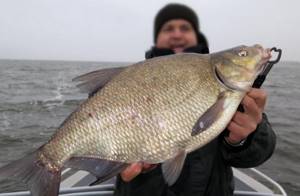
Weight
With age, a representative of the carp family becomes larger. In order to reach at least 5 kg of weight, it will need to exist for about 15 years. The maximum lifespan of this fish can be 23 years. Moreover, its weight can reach 8 kg or more. The following is an approximate table of weight and age.
| Age | Weight |
| 3 years | 250 g |
| 5 years | 900 g |
| 7 years | 1700 g |
| 10 years | 3700 g |
Behavior of bream in different periods of winter
One of the key factors influencing the behavior of fish in winter is the concentration of oxygen in the water. Fishing experience shows the following patterns in the activity of bream schools:
- In the first ice, bream feed very actively, so you can start fishing from 2-3-meter depths.
- Towards the middle of winter, it begins to react less actively to fishing baits and moves to depths of 4 meters, since the oxygen content is higher here. The nature of the activity is changeable - the flock goes to the high ground to feed, and then descends back to the lowland.
- During the deep winter period, especially in stagnant reservoirs, fishermen are often faced with the complete disappearance of bites. At this time, the oxygen content drops to a minimum, so the activity of the fish goes to almost zero. The situation on the rivers at this time may turn out to be more rosy.
- As spring approaches, when meltwater begins to flow into the reservoir, the oxygen concentration increases - and the bream emerges from suspended animation.
If a smaller tributary flows into the main body of water, then in the area where they merge there is a chance to find bream at any time. Oxygen is also brought with the inflowing water, so fish activity will be higher here.
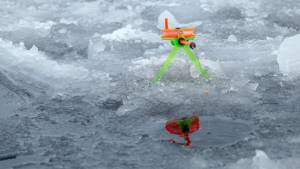
This species is also sensitive to weather conditions. Sharp changes in atmospheric pressure have a depressing effect on it, and biting activity decreases at this time. Moreover, it is not the magnitude of the pressure that is important here, but the fact of its sharp change. After such a change, the bream is passive for some time, but after adaptation it “comes to life” again.
Affects fishing performance and time of day. Often night fishing for bream in winter turns out to be much more effective than daytime fishing. In this case, you should go out on the ice 2-3 hours before the start of twilight, and you can stay at the holes until dawn and several hours after it.
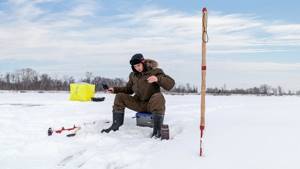
Subtleties of feeding bream flock
If your goal is a big fish, then take into account the authority of the leader. It is he who makes the decision about where the whole flock will swim and where it will feed. In most cases, the bulk of individuals begin to eat only after the leader begins to feed. If he doesn’t like the food you offer, then the whole school will most likely go elsewhere. Therefore, focus on the taste preferences of large individuals.
When choosing a place for feeding, you need to try to find a place where the route of the bream school passes. She moves preferentially along the same trajectory, so getting her to turn to the side can be quite difficult. Again, you need to be able to attract the attention of the leader.
The taste preferences of bream depend significantly on its age and size. Small individuals prefer small crustaceans, which are found almost everywhere, so bream can be fished in a variety of places. Large bream prefers proven bottom areas with variable topography for feeding. You can also try your luck along the edges stretching along the coastline, where there are a lot of bloodworms and jigs so loved by adult bream. Keep in mind that this fish does not chase individual edible pieces, preferring to suck in a large volume of bottom soil and filter out aquatic life from it.
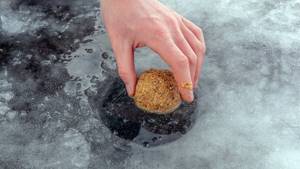
This determines one of the features of catching bream in winter from ice - it should be fed with live bait. In winter, this species prefers food rich in protein to plant food. Therefore, focus on bloodworms and jigs, which remain active in cold water for a long time. Namely, the activity of the bait plays a decisive role at this time - odors spread worse in cold water, so the bream should not smell the bait, but see it. Moreover, it is desirable that the larvae do not remain on the surface of the bottom, but burrow into it. In this case, they will not be eaten too quickly, so the feeding area will be more attractive to the bream.
If you plan to fish in an area of the reservoir that is familiar to you, where bream is constantly present, then you can also use non-live bait. At the same time, it wouldn’t hurt to feed a few more places for the future.
Feeder KZ-2 Dump truck equipped with 0030395 Three whales 61 for 1 piece. Winter colored feeder (Kl) 97 for 1 piece. Large winter feeder Sport 850 for 1 piece. Metal dump truck feeder. height 9.5 cm, diameter 7 cm Helios HS-KD-0043 Helios 93 for 1 pc. Feeder KZ-3 Dump truck equipped with 8947392 Three whales 79 for 1 piece. Winter feeder, ICE Feeder 21 ml, 10 g Salmo 92 for 1 pc. Winter plastic feeder, large Namazu 100 for 1 piece. Winter feeder, ICE Feeder 21 ml, 20 g Salmo 92 for 1 pc. Winter feeder, ICE Feeder 21 ml, 15 g Salmo 92 for 1 pc.
Choose a fish for winter fishing
When choosing between quality and quantity of bait mixture, it is better to give preference to the first. If you pour too much food into the hole, the bream may get full and not be interested in your bait. Therefore, sprinkle no more than a pinch of bloodworms - it must be active, so that with its movements it attracts bream. You can use not pure bloodworms or mormysh, but a mixture of them with store-bought protein mixtures.
If you plan to use feeders, then choose bottom dump truck models. Having sunk to the very bottom of the reservoir, they will create a nutrient cloud, which, with the proper composition, will not leave the bream indifferent. You can flavor the bait with flavorings, but you need to use them carefully. Cold water does not transmit odors well, so pouring in too much of an odoriferous substance will simply create a small area in the water with too strong an aroma, which is likely to scare off the bream. You should not use complex mixtures of odors. If you use a flavoring, then no more than one.
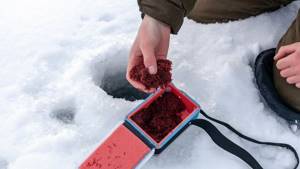
Bream is a cautious fish
One of the main rules of ice fishing for bream is the need to remain quiet. And not only during the actual fishing. It is also not recommended to rattle the feeder; the fish may get scared and run away to a quieter place. In large schools, the leaders - adult and strong fish - are responsible for caution. If he has even the slightest sense of danger, he will not lead the flock into such a section of the reservoir.
Silence must be observed especially strictly in “wild” bodies of water, where fishermen rarely visit. In habitable places, the fish gradually gets used to some extraneous sounds, and it begins to behave more boldly. In poorly fished rivers and lakes, any unfamiliar sound will cause her anxiety. Therefore, it is recommended to place a soft soundproofing lining even under the fishing box to prevent the plastic from squeaking on the ice.
Excessively large gear can also spook the fish. Therefore, you should not mount the largest available bait on your fishing rod. Also avoid sharp transitions from light to shadow, so position yourself near the hole so that it is not obscured by your movements. An excellent option would be to catch bream in winter in a tent - it will block the hole from sunlight, so when you bend over, you will not shade it too much. In addition, fishing in a tent is much more comfortable; it will protect you from both wind and snow. The temperature in a closed dome will also be higher.
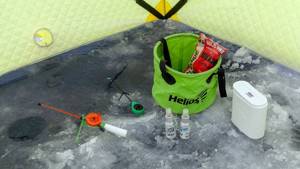
Ready-made groundbait Formula Winter Ready 0.5 kg (SUPER BETAINE-WINTER) ALLVEGA 95 for 1 pack. Aroma gel spray MIX 397 Perch (1 fl.-50 ml) (PDZ-006) PELICAN 206 for 1 pc. Winter bait moistened ICE Bream Red (1 pack - 500g.) (IC-002) 100 BITS 134 per 1 piece. Liquid sponge cake 402 with glitter 500 ml (PB-002) PELICAN 182 for 1 pc. Mega Strike Original universal attractant, gel, 28g (MS-02-1oz) Mega Strike 720 for 1 pack. Prepared bait Formula Winter Ready 0.5 kg winter bream ALLVEGA 95 for 1 pack. Winter bait moistened ICE Bloodworm (1 pack - 500 g.) (IC-008) 100 BITS 134 per 1 piece. Winter bait moistened Roach (1 pack - 500 g.) (PE-026) PELICAN 170 for 1 pc. Ready winter bait Formula Winter Ready 0.9 kg (SUPER BETAINE) ALLVEGA 150 per 1 pack. Winter bite activator. PELICAN Bloodworm (PE-045) PELICAN 242 for 1 pc.
The most delicious baits to choose from
Bream places in different reservoirs
River and lake individuals choose different conditions for living and feeding, which is associated, first of all, with the absence or presence of a current, which forms the bottom topography and affects the distribution of the food supply.
To determine a good place for winter fishing for bream on the current, pay attention to the nature of the bank. A good bite is more likely to occur on steep banks, under which holes and gullies form. Fishing on stepped reaches shows good results. It is better to be located closer to the exit from bottom depressions, as well as near dumps and flooded riverbeds. If the bottom is flat, without noticeable anomalies and not overgrown with algae, then the bream is unlikely to be interested in such an area.
On large rivers, you should fish areas of edges and plateaus, areas under landfills, and the slopes of high slopes. Thus, first of all, examine places with anomalous forms of bottom relief. Even if the bream are not here on your first visit, they are likely to come here to feed. Therefore, it would be a good idea to feed such a place so that the fish stays here longer and check after some time.
In reservoirs with stagnant water, the strategy for finding a fishing spot should be different. The water area of lakes and reservoirs can be very vast, so for a more effective search, divide it into squares, highlighting the most promising areas. These are again areas with bottom anomalies and other objects that a school of fish can use as shelter. An area with a sharp change in height may be catchy.
Ideally, you need to survey the areas of interest before freeze-up. This will help assess the nature of the bottom and understand which zones may be more effective in winter. If it is not possible to find promising places for winter bream fishing due to the warmth, then you can use an echo sounder; some models even work through ice.

Habitat | Bream Habitats
Habitats - in almost all bodies of water in the Northern and Central parts of Europe, rivers flowing into the Caspian, Azov, Black, Baltic and North Seas. And also in some lakes of Transcaucasia, the Amur basin up to the southern regions of China.
Bream prefers deep, quiet lower reaches of rivers, with well-warmed water with a slow flow. Loves overgrown channels, backwaters, holes, quarries, places with a soft muddy bottom.
Usually stays in groups, away from the shore. At night, it can approach the shore and shallows in search of food.
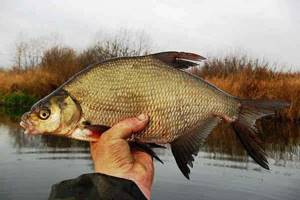
Common fishing methods
Methods and equipment for winter bream fishing can be different - it all depends on fishing conditions, skills and personal preferences. Let's look at the most popular options, highlighting their characteristic features.
Fishing with a float rod
Winter fishing rod PROFI UP-3 with plastic.
handle Three whales 48 for 1 piece. Winter fishing rod Pier 68-Pl. Pier Master 110 for 1 piece. Angler's set for winter fishing No. 3 Three whales 279 for 1 piece. Winter fishing rod Pier 50-B PIRS 79 for 1 piece. Winter fishing rod UD-1 with a semi-detached handle Three whales 52 for 1 piece. Winter fishing rod Pier 55-C PIRS 79 for 1 piece. Winter fishing rod Pier 55-M PIRS 68 for 1 piece. Winter fishing rod WH 56P L200 Pier Master 150 for 1 piece. Winter fishing rod Pier 55-B ABC PIRS 103 for 1 piece. Winter fishing rod WH 56P L250 Pier Master 237 for 1 piece. All winter fishing rods in the catalog
The most commonly used method, whose popularity is due to its versatility. You can use a winter fishing rod with a float at any depth and current; its performance is not affected by either wind force or air temperature. However, such fishing will be effective only with the correct selection of gear. The main rule is a clear weight balance between the sinker-hook connection and the float. It is necessary to strive for a ratio in which the weight of the bundle is slightly greater than the carrying capacity of the float. The latter should not sink sharply, but smoothly - otherwise the bream, feeling resistance, will immediately spit out the hook with bait.
Turned winter double float No. 1 yellow Premier Fishing 58 for 1 pc. Float type 1 (8954245) Three whales 6 for 1 piece. Turned winter single float No. 1 white Premier Fishing 37 for 1 pc. Turned winter double float No. 2 yellow Premier Fishing 58 for 1 pc. Turned winter double float No. 2 white Premier Fishing 58 for 1 pc. Large tablet float (8953537) Three whales 7 for 1 piece. Turned winter single float No. 1 yellow Premier Fishing 37 for 1 pc. Float winter type Small tablet Tayur 7 for 1 piece. Turned winter double float No. 3 yellow Premier Fishing 58 for 1 pc. Float type 0.75 Three whales 5 for 1 piece.
Choose a winter float
The following components are suitable for assembling a winter bream fishing rod:
- rod with a standard length whip;
- open coil design;
- monofilament fishing line with a thickness of 0.14-0.16 mm - it’s better to take a dark one, it will be more noticeable in the snow;
- one or two hooks No. 10-12, however, for catching large fish, the hook size can be reduced to 14-16;
- IMPORTANT: choose hooks with a long shank - on it you can attach a “sandwich” of several types of bait, which will be more attractive to bream.
- a regular or composite float with a carrying capacity suitable for specific fishing conditions;
- sinker - it is better to place several small pellets than one large one.
Dacron gatehouse 350 microns/13 cm, 0.8 g Left-hander-NN 67 for 1 pc.
Gatehouse PM Dragonfly SCHP-L No. 2 Pier Master 70 for 1 pc. Dacron double nod on silicone NOD S-LS15 (140 mm, hardness 0.35) Helios 45 for 1 pc. Dacron nod on silicone NOD S-LS07 (80 mm, hardness 0.20) (S-LS072008 Helios 35 for 1 pc. Dacron double nod on silicone NOD S-LS16 (120 mm, hardness 0.35) Helios 45 for 1 pc. . Conical gatehouse No. 5KCH (03-3.5 g) PIRS 49 for 1 pc. Double lavsan nod on silicone NOD S-LS101 (110mm. hardness 0.50) (S- Helios 64 for 1 pc. Mosquito nose nod Mini 80 mm (350/1.45 – 3 g) 5 pcs/pack Fisherman's talisman 363 for 1 pack PM lavsan guard T 45-140-12 Pier Master 30 for 1 pc PM lavsan guard Bream-T 40-185-50 Pier Master 45 for 1 piece Select a nod for a winter fishing rod
When fishing with a float tackle, bream should be hooked when the bite alarm goes into the water or rises back.

The hook should be confident, but not overly strong - bream has thin lips that can easily be torn by a hook.
Catching bream with a jig
Winter sports fishing rod Balalaika US-2 Three whales 48 for 1 piece.
Winter fishing rod (balalaika) (Winter 1) Tonar 74 for 1 piece. Winter fishing rod. RBUZ green fiberglass whip (RBUZ-G) Helios 300 for 1 pc. Winter fishing rod. SPZ red fiberglass whip (SPZ-R) Helios 285 for 1 pc. Winter fishing rod. RBUZ yellow fiberglass whip (RBUZ-Y) Helios 300 for 1 pc. Winter fishing rod. SPZ green fiberglass whip (SPZ-G) Helios 285 for 1 pc. Fishing rod winter filly North, 340 mm, 117230 AQUA 70 for 1 piece. Winter balalaika fishing rod Ice Ecorod 01 yellow 25 cm Salmo 85 for 1 pc. Winter fishing rod. STFS yellow (STFS-Y) Helios 193 for 1 piece. Winter fishing rod. STFS green (STFS-G) Helios 193 for 1 piece. All winter fishing rods in the catalog
Another popular fishing method that shows good results even during periods of deep winter. The main task of a jig when catching bream with it is to deliver the bait to the bottom of the reservoir. However, it also attracts the attention of fish quite well. The color of baits can be different, mostly fishermen use silver and black options; it is better to select them yourself for a specific body of water. Different shapes are also suitable - you can experiment with all the options from pellets to nail guns and flies. The hook should be large enough to easily attach several bloodworms at once.
Recommendations for completing jig tackle:
- light and sensitive fishing rod 18-30 cm long;
- a nod of medium hardness, the length of which should be chosen in the range from 7 to 16 cm - in particular, you can use a clock spring or a lovsan nod, which, due to its rigidity, can ensure self-hooking of pecked fish;
- reel of reliable design;
- monofilament line with a diameter of 0.1-0.17 mm, about 20 m long
- a heavy jig that can quickly deliver a bloodworm or jig to the bottom of a reservoir.
Jig Nailball black banana, cheese cube Premier Fishing 69 for 1 pc.
Jig Cat's eye 0.58g suspension d2.0 yellow Premier Fishing 67 for 1 pc. Jig Nailball black banana, chameleon cube Premier Fishing 69 for 1 pc. Jig Gvozdesharik green, multi-faceted hamel ball Premier Fishing 69 for 1 pc. Jig Cat's eye 0.58g suspension d2.0 green Premier Fishing 67 for 1 pc. Mormyshka Garlic with hole. goat 3mm 0.63g (MW-K1530-Go) Helios 61 for 1 pc. Mormyshka Ant gran. with hole. 4mm 1.03g (MWC-K3440-Sil) Helios 89 for 1 pc. Mormyshka Maggot with eye color. 135-1 Helios 83 for 1 piece. Cast jig Garlic Small No. 15 0.4g. (X) PIERCE 16 for 1 piece. Choose a suitable jig
When fishing with a jig, you need to be prepared for the fact that you will have to actively search for bream throughout the reservoir. Having reached the chosen place, drill a hole, throw in a starting portion of bait, and then lower the jig into the hole. Without sudden movements, lay it on the bottom, then briefly lift it up several times - the jig should tap on the bottom. When lifting the bait, the nod should swing smoothly, without jerking. You can determine the moment to hook by the position of the nod. If it rises up, it’s time to hook.
Bream on jigs work better in reservoirs with stagnant or weakly flowing water. For fast-moving rivers it is better to use a winter feeder.

Fishing for bream on the devil
A little devil equipped with three hooks is perhaps the main tool for fishing for this fish. The fact that bream like it is confirmed by the experience of several generations of fishermen. The most catchy options have an elongated narrow body from 1 to 2 cm.
The body is most often painted black, green or red. To make the devil even more attractive to fish, cambrics or beads can be added to the hooks. But there should not be a lot of it, otherwise there is a risk of scaring off the cautious bream. Therefore, just a few beads of contrasting colors are enough.
Tungsten jig Devil with cube Chameleon Premier Fishing 49 for 1 pc. Jig tungsten Chertik tee with hole. and beads. 3mm 0.67g Bn (MW-3030-Bn) Helios 95 for 1 pc. Jig ChM hook HAYABUSA Y.CHK 128 Tula 188 for 1 pc. Tungsten jig Devil triangular with a ring 2mm 0.43g Cu (MW-3220-Cu) Helios 89 for 1 pc. Wolf jig.Devil with hanging tee with fly 3mm 0.85g Sil,MW-5430TF-Sil Helios 150 for 1 piece. Jig tungsten Chertik tee with hole. and beads. 3mm 0.67g Ni (MW-3030-Ni) Helios 95 for 1 pc. Tungsten jig Devil triangular with a ring 2mm 0.43g Sil (MW-3220-Sil) Helios 89 for 1 pc. Devil with hanging hook Spider-Doll 0.4g (Z) PIER 59 for 1 piece. Tungsten jig CHERTIK with loops. Lucky John 030/10 (824030-10) Salmo 68 for 1 piece.
Winter devils in assortment
Catching bream with a “Devil” type reelless reel requires a balanced ratio of the mass of the bait and the rigidity of the nod. You need to play the devil with a large amplitude, but without sudden movements. The movement of the bait is from the bottom up and back. Choose the height to which the bait can be raised taking into account the activity of the fish. If the bream is active, then it can follow the devil and almost to the very surface. During periods of calm, it is better to concentrate on the bottom water column.
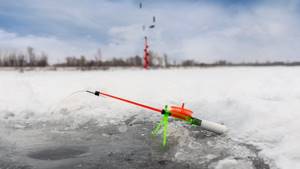
Bream (Abramis brana)
Bream (Abramis brana)
Zaraisky D.A. "Fishing"
Bream is a lake and river fish, distributed throughout the European part of the CIS. It lives in all large rivers, reservoirs, large floodplain reservoirs and lakes. In the Caspian and Azov Seas, bream adapts to living in slightly salted water. Absent in small fast and mountain rivers, as well as in small lakes. It has commercial significance. Bream is bred in commercial nurseries near reservoirs, where there are no favorable conditions for its spawning. Here, sufficiently strong juveniles are raised, which are then released into reservoirs.
Features of body structure and coloring
The appearance of the bream is remarkable in its own way. Its body is very tall, laterally flattened, covered with thick, tightly fitting scales. Because of this body shape, the bream was even nicknamed “shovel”. The dorsal fin is high but short, the subcaudal fin is twice as long as the dorsal fin. The large caudal fin is divided by a notch into two lobes - upper and lower, of which the lower one is longer. The bream's head is small compared to its body. The mouth is small, semi-lower, like an accordion, with lips extending into a tube. The eyes are also small, with golden irises. The color of the bream depends on its age and living conditions. Lake bream are usually darker than river bream. Young bream are lighter in color than adults because they are covered with bright silver scales. Adult fish have darker scales, with a yellow, gold or copper-red tint. The general body color of the bream is silver. The head, back and upper parts of the sides are blackish-gray. The belly is narrow, dirty yellow, with dark spots, and covered with mucus. All fins are gray, in larger specimens they are darker, with a purple tint.
Dimensions, weight and age
Bream grow unevenly in different bodies of water. It is somewhat better in reservoirs than in rivers before they were regulated, since there are larger feeding areas, which affects growth. The growth of individuals of both sexes is most intense during the first three years of life. As a rule, males grow more slowly than females. Bream lives for about 13 years. Sometimes it reaches a length of 75 cm and a weight of more than 6 kg. A kilogram bream with a length of 35 cm is not that uncommon in amateur catches. More often you come across bream weighing about 0.8 kg. In reservoirs with unfavorable habitat conditions, bream forms slow-growing forms. Bream reaches sexual maturity at the age of 3-6 years. At the same time, females mature a year or two later than their male peers.
Spawning: timing, places, nature of passage
During the spawning period, bream gather in schools according to age groups. Males are inferior in weight and size to females, but they are more numerous. Before spawning, the spawners darken, and the body of the males becomes rough to the touch, covered with small warts - whitish tubercles of the nuptial plumage. Spawning continues for one month. Cold weather slows it down and may even interrupt it. Then the fish goes deeper, reappearing on the spawning grounds on the first warm and sunny day. If bad weather drags on, the females may die without laying eggs. On artificial spawning grounds, bream can lay eggs regardless of weather conditions at depths of over 6 meters. The noise on the spawning grounds frightens the bream, and spawning is interrupted. That is why, in spawning areas, fisheries authorities ensure peace and quiet, and the movement of boats, especially motor boats, is limited at this time. Schools of bream, having fed up in the salty areas of the seas, rush to the lower sections of the rivers immediately after the ice melts. Here they fatten for some time. Bream living in reservoirs also tend to move during spawning. They migrate both to the upper reaches and to the estuaries of rivers. Spawning begins when birch buds open - in mid-April (in the south), when the water warms up to a temperature of about 11-12 degrees and continues until mid-June, when the water temperature is 22-23 degrees. Spawning sometimes lasts for 5-9 weeks. On spawning grounds, bream sticks to deep places, and for spawning it goes to the coastal zone covered with vegetation. It lays eggs mainly in floodplains of rivers, on flooded meadow vegetation, on washed away roots of trees, reeds, and reeds in shallow bays. The depth of the spawning area can vary from 0.2 m to 2.5 m. The current in the spawning areas is usually absent or does not exceed 0.5 m per second. After spawning, the spawned fish immediately moves to deeper parts of the reservoir, often to their holes, and after a short rest (less than two weeks) begins to feed intensively. Semi-anadromous bream, which lives in the lower reaches of large rivers, after spawning, moves to the sea to fatten.
Habitats and fishing locations by season and time of day
Bream is a schooling and family fish; it rarely lives alone. The number of individuals in the flock increases in autumn. During a walk, a flock of bream resembles a flock of wild geese led by an experienced leader. They usually swim in a triangle, like geese fly, and at the top of the triangle is the largest fish. In anxious moments, the flock stops and mixes, and the leader swims slightly to the side and becomes slightly higher than the flock. Then he makes a sharp turn, and the whole school rushes after him. The sedentary form of bream is found in almost all rivers, lakes and reservoirs. If this fish is not disturbed, it lives in one place for a very long time, without making large movements. Bream prefers warm water. After spawning (from May to early June), bream can be caught well in baited areas. Almost all the time in summer, bream is found in the bottom layers of water in deep areas with a clayey, sometimes sandy, slightly silted bottom, near rifts near steep banks, at the exits of their pools and holes, where the current is slow or absent, avoiding snags and dense thickets of plants. In river beds, the paths of movement of bream usually run in the deepest places, along underwater hollows and gullies along the main bottom current. During the day it stays in the pits, hardly feeds, and if it bites, it is very sluggish. It can often be found under rafts and near thickets of aquatic vegetation - reeds, reeds, amphibian buckwheat. In the evening, at sunset, it comes to feed in smaller areas, to the edges of the bottom - in the coastal zone or underwater elevations. Schools of bream can visit the same places for a long time if they are rich in bloodworms. Moving along deep underwater paths while feeding, bream rise to muddy shallows overgrown with aquatic vegetation and shallow reaches, but avoid heavily overgrown and wetlands. At night, bream gather in large numbers in areas of underwater elevations surrounded by deep water. On bright nights fishing is more successful. It has been noticed that bream is less catchable when the month is young and when the water level rises. When the water level drops it bites very well. Before dawn, the fish descend deeper, but until almost noon they continue to feed in places with a stepped bottom, and then go deeper into holes, where they stay until sunset. Bream constantly feed at night, so they are caught at this time, but only where night fishing is not prohibited. Many anglers believe that in the summer the best places for catching bream are on the ledge bottom, inhabited by colonies of pearl barley. At the beginning of summer, bream are caught at a depth of up to 1.5 m, and in the middle and end of summer - at depths of up to 3 m. In warm, calm weather, often before sunrise and sunset, bream can rise to the surface of the water and “play” in the middle of the river . At the same time, they either throw themselves up, or walk like a wheel, showing their tails and heads, or, rising to the surface, they leave behind widely diverging circles. They also love to turn around on the crest of a wave created by a sailing ship. On calm cloudy days, bream continue to feed in relatively shallow places. On such days, when fishing in shallow water, the fish do not come close to the angler or the boat. The behavior of small bream - bream - is not so orderly. Their movements around the reservoir are mainly associated with the search for food. On the hottest days of summer, coinciding with flowering waters, bream do not leave the pits at all. And only with cold weather, towards the beginning of autumn, does the bite resume. This period coincides with the beginning of the death of aquatic vegetation. At such times, fish do not appear in shallow water, where the water cools down overnight, but are located at the lower edges of the ledges. Before freeze-up, by mid-November, bream stop moving and switch to a sedentary lifestyle. Schools of these fish, sometimes very numerous, gather for the winter in deeper places, in pits. The breams make some movements under the ice without rising above the average depth. In large bodies of water (rivers and reservoirs), bream can move slowly and feed even in winter.
The nature and characteristics of nutrition. Nozzles, baits, bait
Juvenile bream feed mainly on crustaceans and mosquito larvae. Adult bream feed on bloodworms, and to a lesser extent on worms, mollusks, crustaceans and plant debris. They do not disdain the eggs of previously spawned fish (pike, perch). The bream sucks young shoots of vegetation, making smacking sounds. It digs through the mud, revealing itself on the surface of the water with characteristic small bubbles. Looking for food at the bottom, the bream stands head down, takes an almost vertical position, extends its mouth (proboscis) and sends a strong stream of water into the ground. The stream erodes the surface of the bottom and exposes larvae and small mollusks hiding in the mud, which the bream then picks up with the same accordion trunk. After this, he quickly “wipes his lips” - makes a peculiar movement with his mouth. The larger and fattier the bream, the less intensively it feeds. In the coastal zone, bream feed more actively than in deep places. In the spring and early summer, bait and complementary foods for large bream are prepared from whole and crushed worms, rolled into clay balls that are difficult to wash away with water; in the fall, from earthworms and bloodworms. Steamed oats, bran, porridge and cottage cheese are also used. Bloodworms, caddisfly larvae, bark beetles, mayflies, grasshoppers, small earthworms, maggots, and crayfish meat are placed on the hooks. Particularly tasty baits for worms are blizzard (newly hatched mayflies), earthworms and insect larvae (especially bloodworms). The most catchy bait is considered to be a “sandwich” made of bloodworms and worms (or moth instead of worms). Bait easily holds the bream at the fishing spot.
Tackle
Bream is caught mainly with float, wire and bottom fishing rods. For large bream, the tackle is made to be very durable, with a powerful rod and a large load-bearing tip. The fishing rod is equipped with a fishing line with a thickness of 0.3 to 0.5 mm, leashes with a diameter of 0.15 to 0.3 mm and a hook No. 5-7 or more, with a long tip and a short fore-end. Larger equipment is used for wire fishing. A small sliding sinker is placed on the bottom fishing rod, and a spinning rod equipped with a reel is usually used.
Biting, hooking and fishing
A bream bite can always be distinguished from others, especially when fishing with a float rod in a weak current or in stagnant water. The fact is that the bream takes the bait from the bottom, becoming almost vertical, and having taken it, it takes a horizontal position in order to swallow deeper. As a result, the leash with the sinker and part of the main fishing line rise above the bottom, and therefore the float rests on the water. Swallowing the bait, in which the float lies on the surface of the water and only trembles, occurs within 10-20 seconds. Then the bream begins to swim to the side and takes the float with it, which gradually sinks. At this moment, make a short but sharp hook with the tip of the rod. When fishing with a bottom with a sliding load, they hook when the line is first slowly and weakly tensioned, and then sharply, but not strongly, begins to twitch (the bream drags the bait to the side, swallowing it as it goes). When fishing in the wire, they hook it after the float rests on the water. When fishing in the current, the hook is made at the final bite - a strong tension on the line when it begins to unwind. This means that the bream tends to carry the bait away from the place where it is captured. Previously, it was difficult to determine the right moment, since the fish first only twitches the line. During the current, the bream holds the bait more firmly than in standing water. The hook is made sharp, sweeping and strong - to overcome the resistance of the water. It is advisable to place fairly flexible nods or bells on donks. Hook during a series of nod deflections or during frequent ringing of the bell. A hooked bream freezes in the first few seconds, and then tightens the line and tends to move away. Its resistance in the first moments is so strong that it seems as if the hook is caught on a heavy object. However, the vibration of the line during jerks gives the fish away. The bream needs to be brought to the surface a couple of times so that it takes a breath of air. Then he lies down on his side and allows himself to be pulled towards the landing net.
Fishing for bream in winter
Bream is caught from the ice with a winter float rod, usually equipped with one or two jigs, or with a jig fishing rod with a nod. In the second case, the bait is given certain smooth vibrations. A fishing line is used with a diameter of 0.12-0.17 mm, a length corresponding to the fishing depth, with some reserve. Jigs are tied at a distance of 15-20 cm from one another, choosing them experimentally. As a bait, several bloodworms are used, put on a hook using an elastic band (nipple or from a rubber ball), pieces of earthworms, etc. Bream is caught on the first and last ice in its mooring areas - in holes up to 12 m deep. At the end of winter it Together with large roach, it leaves its wintering grounds and moves against the current. It bites throughout the day. You need to look for it in the bottom layer of water on the slopes of wintering pits, as well as on fish “paths” along the main banks of rivers, near the skeletons, near gullies and ravines, choosing narrow deep places. They usually catch white bream (weighing up to 0.7 kg) in winter, because they “can’t sleep.” Large bream have enough fat to survive the winter, but young ones are forced to look for food under the ice. Having caught several fish, they move away from the hole for some time. The bream remaining in this place continue to feed and attract other relatives with their characteristic smacking sounds. Returning to the hole, you can continue your successful fishing. The bream bite is characterized by the bouncing of the float in the hole or the deflection of the nod. The float can emerge from the water or quickly go deeper. The nod can straighten - rise along with the fishing line. In still water, you need to hook sharply and briefly, in the current, quickly and sweepingly. The bream rises into the hole on its own, but sometimes it may not fit into it. At the end of winter, you need to change the fishing line to a stronger one, and small jigs to larger ones, since at this time the bream become stronger and it becomes more difficult to catch them.
Bream as an object of interest
Bream is extremely popular among amateur fishermen. Cautious, reacts sharply to noise and unusual objects. It can rise to the surface and “study” the area if it discovers something that seems suspicious to it. Catching bream (especially large ones) involves a number of pleasant difficulties. In addition, this fish is quite large. Catching it is often effective, and bream meat is famous for its fat content. Bream is of commercial importance. It is recommended to introduce it into those lakes and reservoirs where bottom food organisms develop abundantly.

